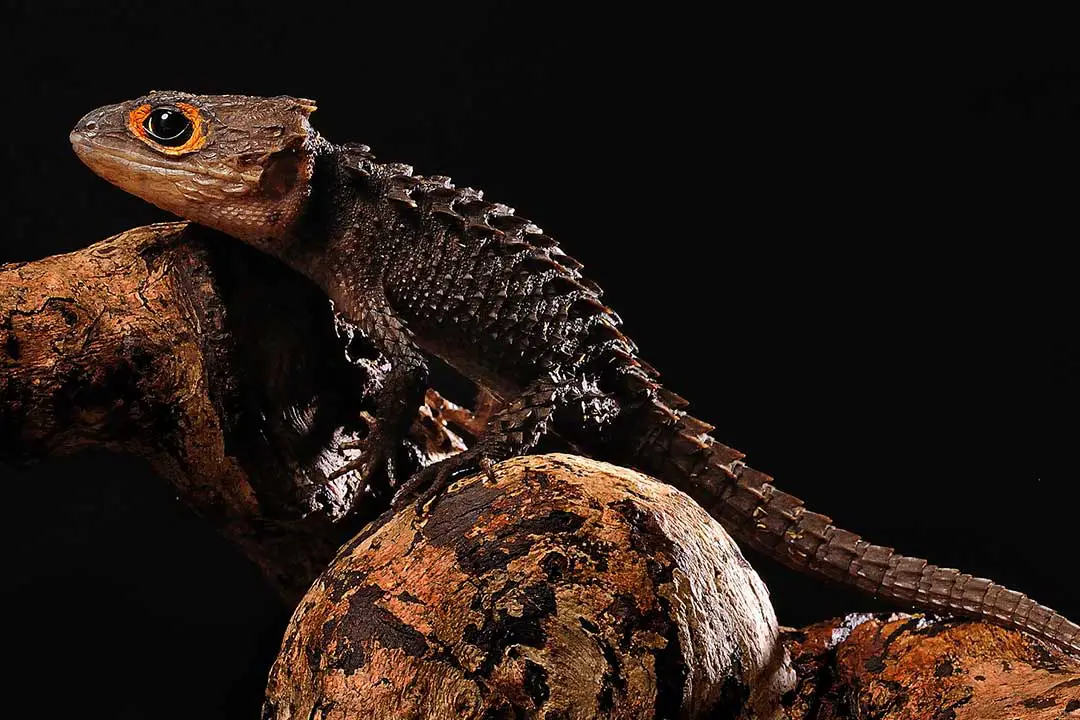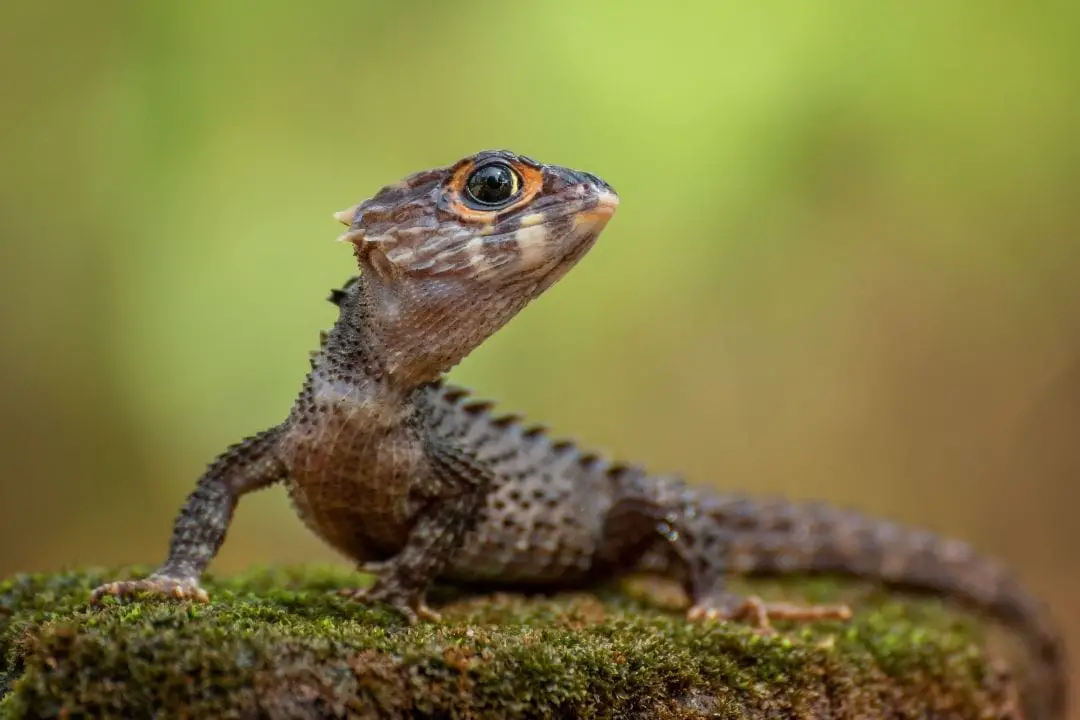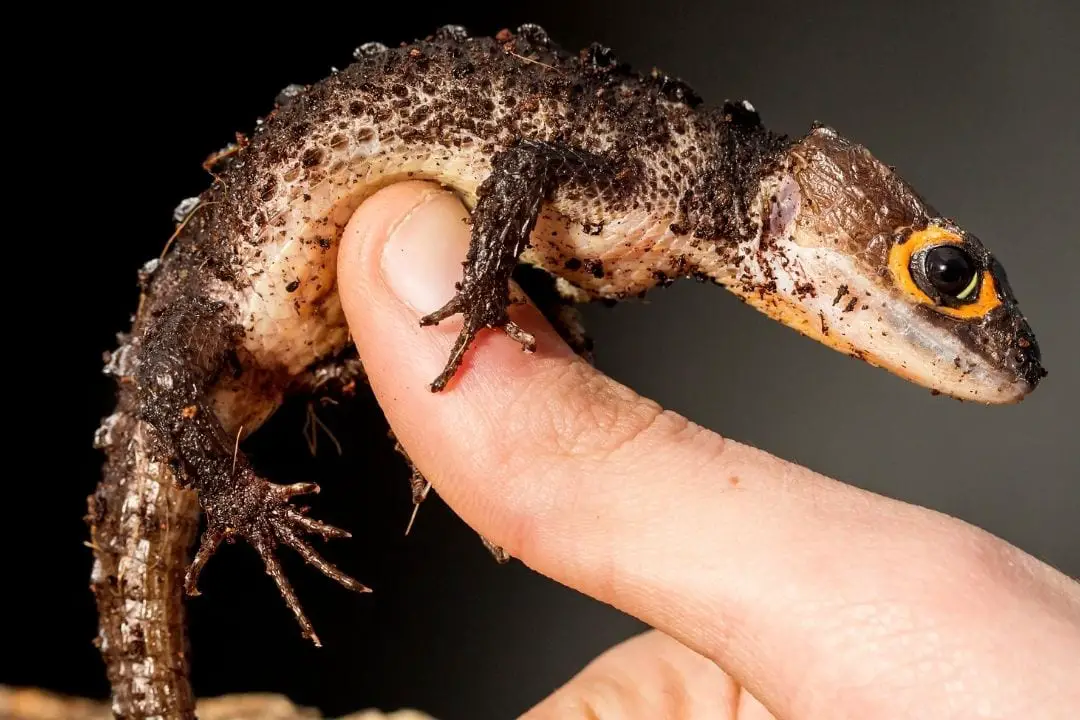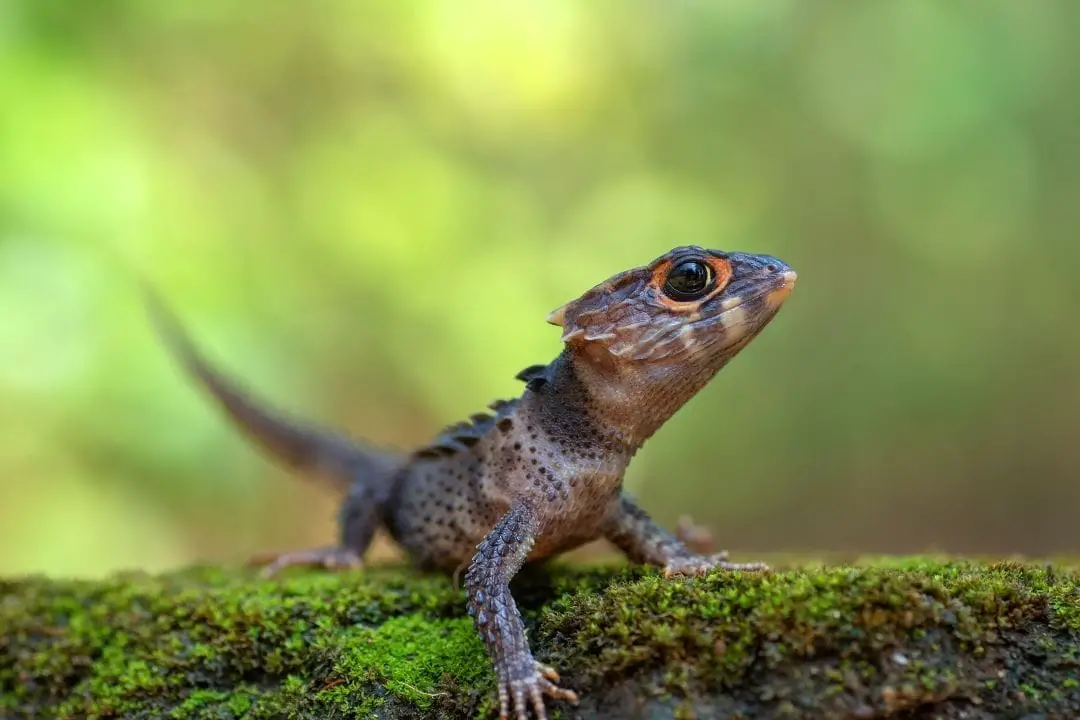The red-eyed crocodile skink (Tribolonotus gracilis) are one of eight species of skink in their genus with similar spiny appearance and semi-fossorial habits.
These animals are native to Papua New Guinea and Indonesia.
They are found near sources of water in the wild and have a diet that includes insects, fish, and similar small animals. They are unique because they practice parental care and also vocalize regularly.
One thing to note with the species is that they are rarely available as captive-bred animals.
Like other reptiles, wild-caught animals are more difficult to care for and more likely to die early due to illness, injury, and parasite load.
I do not suggest this species for anything other than an advanced keeper with a large amount of experience with tropical lizards due to the trials of caring for wild-caught and low-generation captive animals.
Captive-bred animals may be easier to care for, but they are hard to find and generally more expensive.
Farm-bred lizards are virtually the same as wild-caught, so treat them the same and be sure to get the animal an immediate checkup and battery of tests at your reptile vet.
Housing
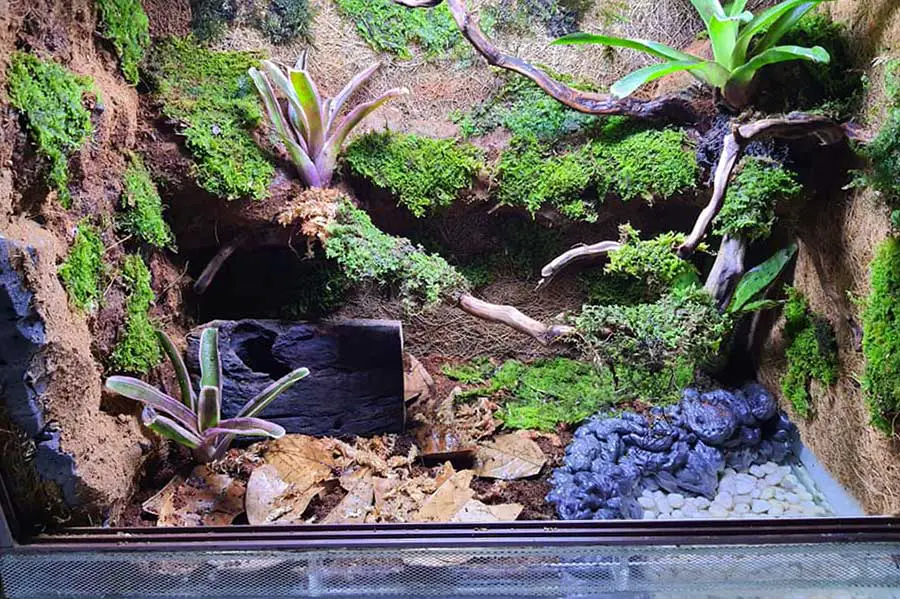
Since these animals are native to warm and humid climates, you need to create an enclosure that will trap humidity and keep in heat well.
They are also found near water in the wild, so creating a water feature or large water dish is highly suggested. This will also help keep up the humidity.
This species also burrows, so you need a deep substrate. We will go over substrate choice. If you feel confident with using live plants, I highly suggest a bioactive setup for this species.
We will not go over how to do this, but most of the setup is similar aside from the insects and the plants. You will not need to offer UV if you use live plants since they require grow lights.
If you are breeding your skinks, we will also go over what you need to allow the animals to breed successfully.
Since the species does practice parental care, it is very possible for you to allow your skinks to hatch their eggs and care for the hatchlings.
Enclosure
Since red eyed crocodile skinks are mostly terrestrial, I suggest aiming for a longer enclosure rather than focusing on height.
They will climb and you should have enough height to use a branch as a basking spot, but 12 inches tall works as a minimum.
They need more room for hides and a water dish they can swim in. They also prefer to burrow a bit under the hides, so ensure you can offer a deep layer of substrate even if you choose not to do a bioactive setup.
The ideal material for an enclosure is actually PVC or wood. Both of these are very good at holding higher humidity and will still allow you to look at your pet, but wood will need to be sealed carefully.
Glass can work, but it doesn’t hold humidity as well due to the screens you need to allow for good ventilation.
If you choose glass, I highly recommend using an automatic mister and using additional moss to help keep up humidity.
These animals are very prone to poor sheds and losing toes due to poor shedding like other small lizards.
Red-eyed skinks can be housed together with their juvenile offspring or with a mate. They should not be housed as more than a pair.
Enclosure size for a Juvenile Red Eyed Crocodile Skink
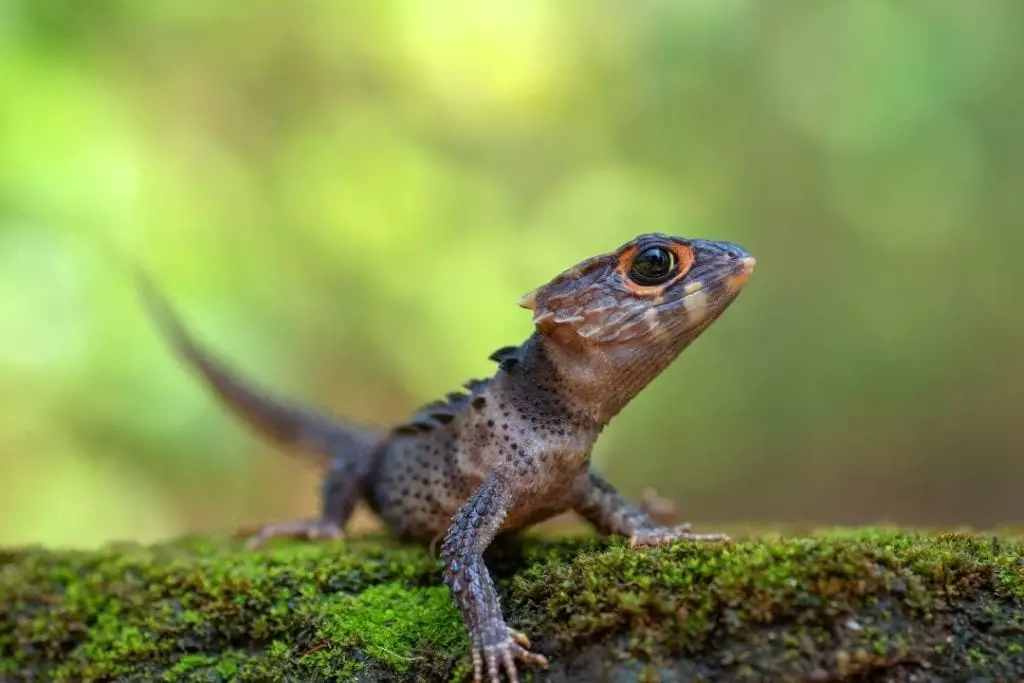
Juveniles can be housed alone in a 12″x12″x12″ enclosure.
This makes it a bit easier to make sure your baby red-eyed crocodile skink can find its food and water.
Stick with front-opening if at all possible to make sure your baby skink isn’t stressed when you need to handle it.
Enclosure size for Adult Red Eyed Crocodile Skinks
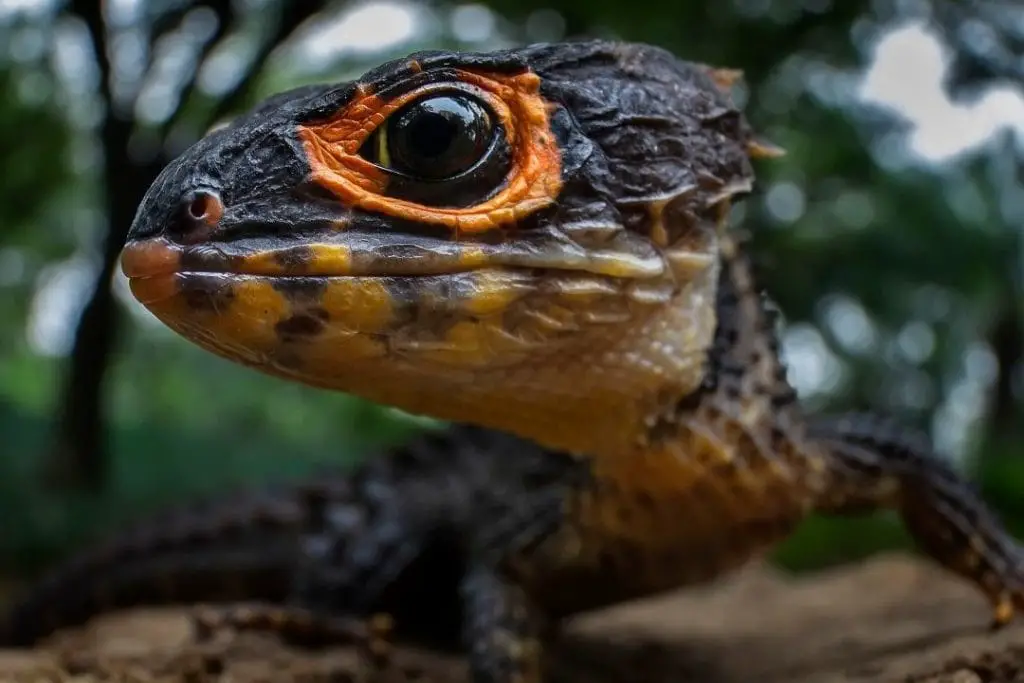
Adult red-eyed crocodile skinks need a minimum enclosure size of 18″x18″x12″. I do suggest going longer if you can. If you plan on housing a breeding pair, you will need a longer enclosure with twice the amount of hides and two good basking spots that are identical in temperature.
If you house your skinks together, you need to offer two hides that are identical in temperature and humidity on both the warm and cool sides.
The skinks will fight over the better hide if there is a difference.
You will also need space for the female to lay her eggs. She can handle caring for the eggs if you provide her moss and cork bark to hide the eggs.
This enclosure from custom reptile habitats is a great choice for a pair. I highly suggest this if you have more money or are struggling to keep up the humidity.
The screen on top also doesn’t block UV and will help keep your skinks from being burned on the bulbs.
Substrate
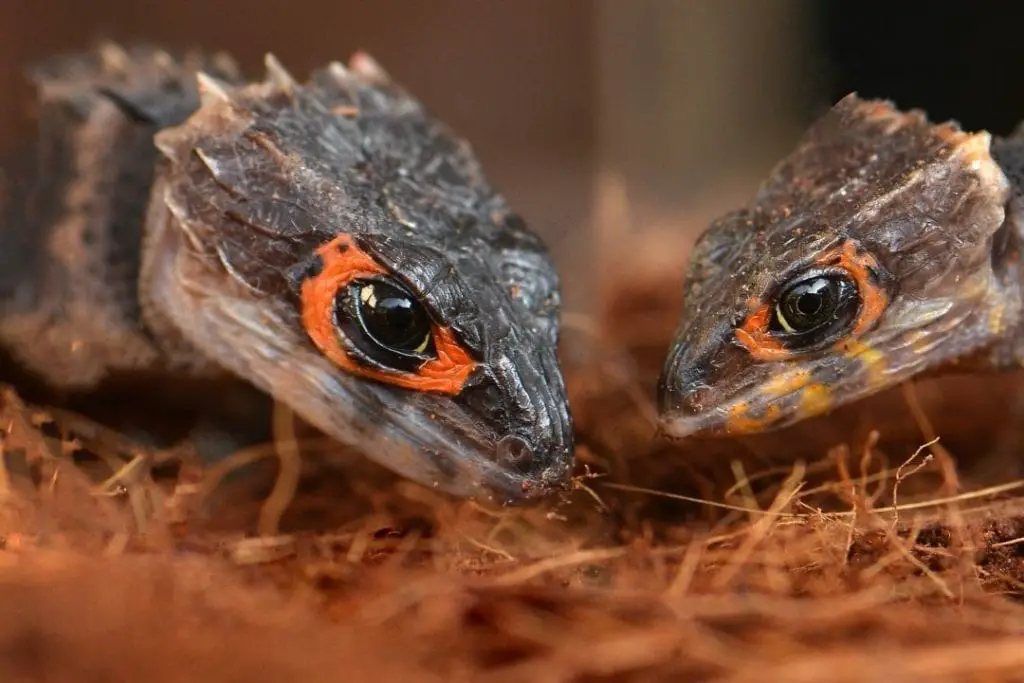
For substrate, I suggest a good humidity retaining substrate that allows for burrowing behaviors.
EcoEarth’s dark brown coconut substrate is a great choice, some people use cypress mulch as well. You can also blend moss and organic soil to create your own substrate.
If you go bioactive, make sure you use appropriate soil. Leaf litter is a great choice to allow these semi-fossorial animals a chance to hide. This will also make higher humidity areas the skink can use as it needs.
Do not use paper towels
I do not suggest paper towels as anything other than a quarantine substrate. It does not hold humidity well and will not allow your skink to dig as they prefer. A skink that can dig a bit is a happier animal.
Do not use reptile carpets due to the risk of catching the animal’s toes. Reptile carpet is also nearly impossible to clean properly.
Never use cedar or pine since it is toxic. I do not suggest aspen or any drier substrates as well since they typically mold at high humidity.
Temperature
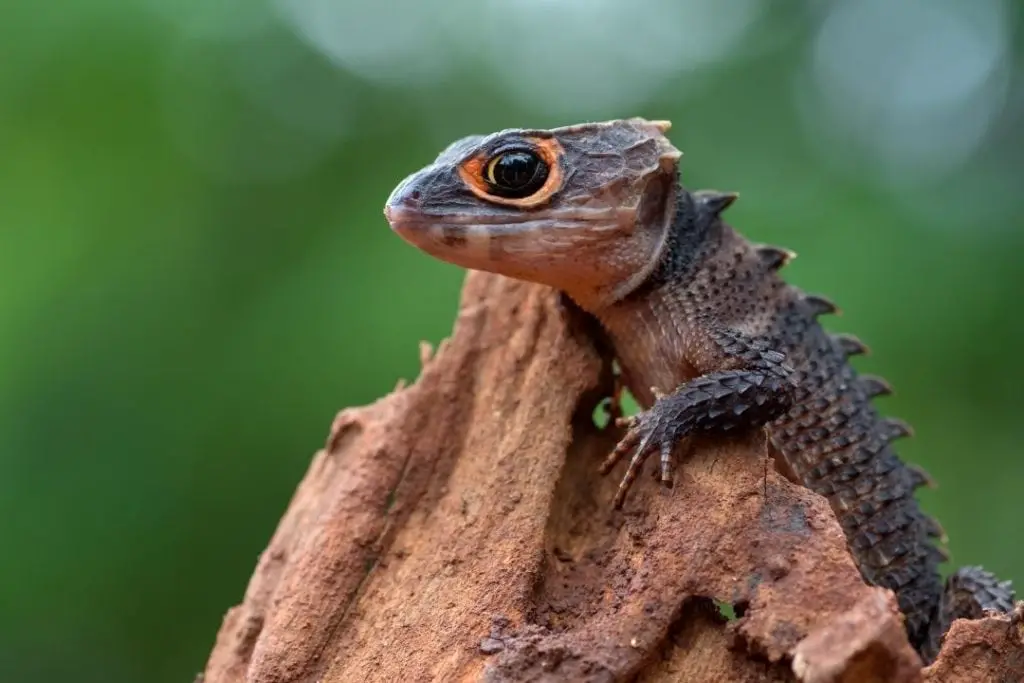
Red-eyed crocodile skinks prefer lower ambient temperatures. They do like a basking spot and a simple 25w incandescent bulb like this will work.
Set this in a good dome and be prepared to use a stand if the basking spot is too hot. Be careful to protect your skinks from touching the hot heat lamp.
What is the correct temperature for a red-eyed crocodile skink enclosure?
The temperature in a red-eyed crocodile skink enclosure should be around 80-84 degrees Fahrenheit at the basking spot. Do not let it get higher than 86 degrees since this can kill a skink. Ambient day temperatures on the warm side should be around 76-78 degrees.
The cool side shouldn’t drop lower than 72 during the day.
Night-time temperatures can go as low as 68 degrees. If it drops lower, you can use a heat mat (under the tank heater) attached to a thermostat to keep the temperatures up enough.
If you ever struggle with humidity, place the heating mat under the water dish.
Light
I highly suggest offering a 5.0 UVB basking light for red-eyed crocodile skinks.
Do red-eyed crocodile skinks need UVB?
Red-eyed crocodile skinks need some UVB and will benefit from a UVB light source. While they are crepuscular and can survive without it, they do appreciate the opportunity to bask and get light.
UVB lighting can help recreate a proper day and night cycle and will provide the much-needed vitamin D to your skink, strengthening the immune system and facilitating growth and better digestion, amongst other benefits.
Any lighting should be on for 12 hours at a time and turned off at night. Use a timer to control it.
Do not use colored lighting since it can bother reptiles and harm their eyes.
Shelter and Enclosure Design
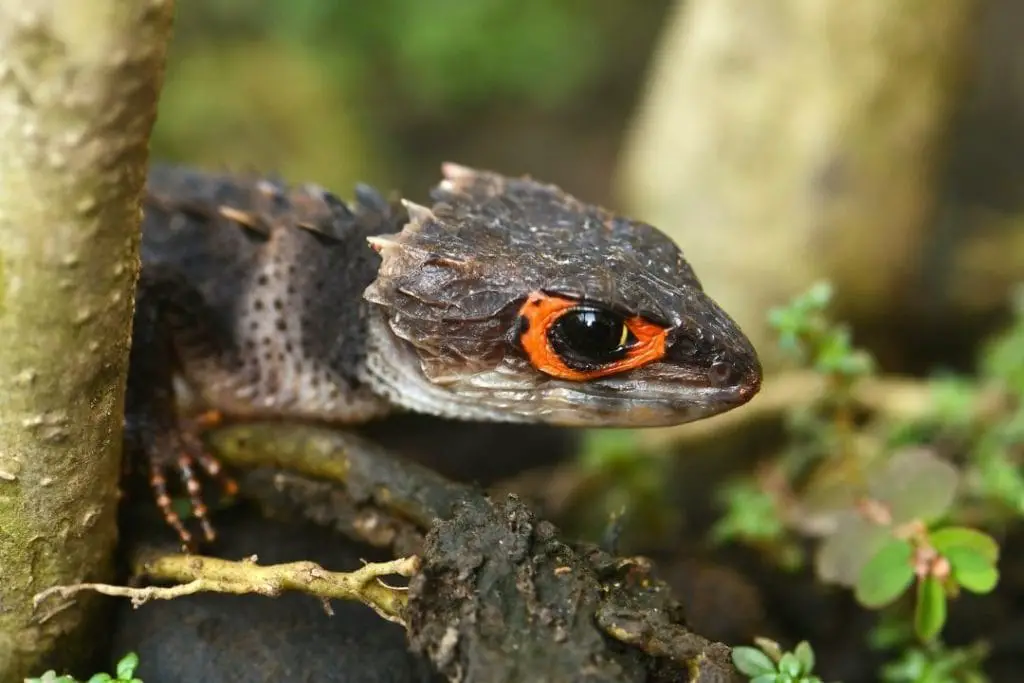
I highly suggest live plants if you can keep them alive to help with humidity. Crocodile skinks do not always recognize the water dish as anything other than a swimming pool, so live plants catch and hold more water for your skink.
If you cannot keep plants alive, I still suggest offering fake plants for cover and climbing. The species needs at least one hide on each side of the enclosure for every adult animal you have.
They do burrow a bit, so make sure any hides are light enough not to crush your skink if it digs under it. Large coconut huts work well.
You can also bury the hides in the substrate a bit to help protect the animal.
You should also offer a humid hide per animal filled with damp moss to help keep the skink healthy.
Branches are a good idea to allow for climbing and make good basking spots. While crocodile skinks are light, you should still secure any decorations to make sure they will stay stable as your skink climbs around.
Water
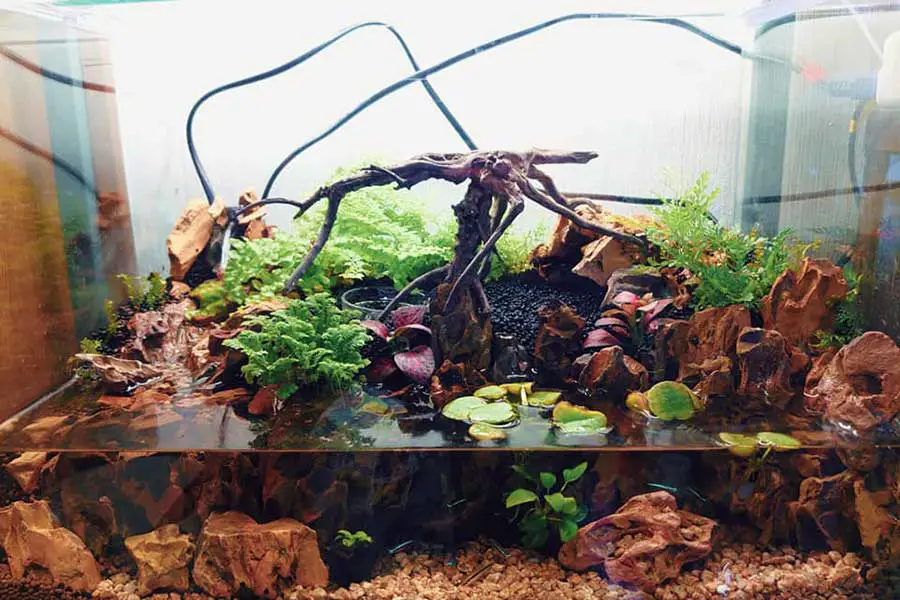
Red-eyed crocodile skinks love to swim. They prefer a water dish large enough to allow the skink to fully submerge and swim.
If you feel confident enough, a small water feature that you add a ramp to will allow your skink to swim and climb out safely.
Otherwise, get a large water dish buried partway into the substrate, allowing the skink to climb in easily. It should be fairly deep but add small rocks or pebbles that your skink can use to climb out, so it doesn’t risk drowning.
Ensure the dish is easy to clean since skinks love to drag in the substrate which make regular cleaning necessary.
Humidity
Red-eyed crocodile skinks need high humidity.
What is the required humidity level in a red-eyed crocodile skink enclosure?
Red-eyed crocodile skinks need between 70-90% humidity. Once your skink is ready to shed, keep it on the higher end of the range.
You will need to mist the enclosure at least twice a day or setup a mister to help maintain humidity at the right levels. peat moss can help retain humidity longer.
A reptile fogger or automatic misting system is a great choice for this species. I highly suggest you use a digital hygrometer and have a backup meter for any species that requires such a high humidity level.
Maintenance
Daily maintenance for a non-bioactive enclosure includes spot-cleaning any feces and replacing the water. You should take the time to check the water during the time you mist the enclosure.
You will need to clean the water dish with hot water and soap once a week at least and watch out for hard water buildup.
Finally, all non-bioactive enclosures need a deep clean once a month. All decorations must be cleaned or replaced, and the substrate must be tossed out and replaced.
The enclosure needs to be cleaned with a reptile-safe sanitizer and thoroughly rinsed and dried before you start filling it with substrate again.
Feeding
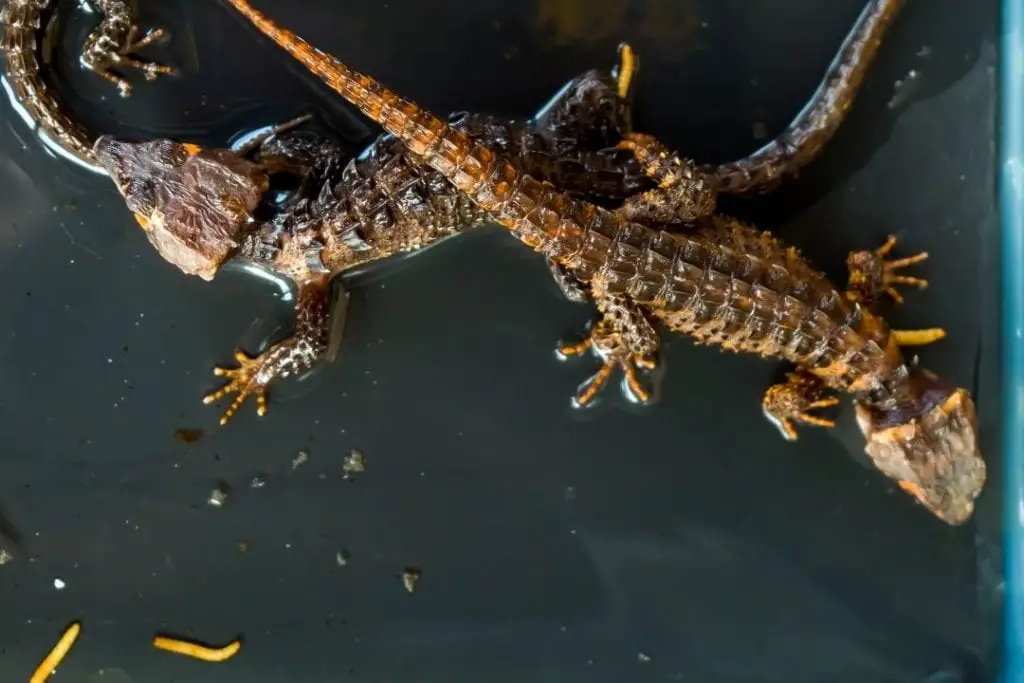
What do red-eyed crocodile skinks eat?
In the wild, red-eyed crocodile skinks prefer insects, but they will eat other small animals like fish they can catch. In captivity, you need to offer gut-loaded insects.
Feeder insects should be no bigger than half the size of the skink’s head.
Since they are crepuscular, offer meals either in the early morning when their lights come on or at night when they are shutting off.
Any uneaten feeder insects should be removed to prevent them from hiding or biting your skink.
Diet
Dubia roaches and live crickets will make up the majority of the diet for the entirety of the skink’s life. Juveniles will eat crickets under 1/4″ and roaches of a similar size.
Adults will eat the same small insects about half the head’s size. They should be gut-loaded, dusted with vitamin and mineral powder, and offered in a dish.
Skinks will eat about 6 insects in a feeding and anything they don’t eat should be removed after an hour.
Treats
Treats can include waxworms or butter worms. Since they are fatty, try only to offer treats to adults or thin skinks. You can also offer small fish in the water dish, but ensure they are safe for reptiles.
Many fish species, like goldfish, have an enzyme that can cause vitamin deficiencies.
Frequency
How often should red-eyed crocodile skinks eat?
Juvenile red-eyed crocodile skinks eat daily to stay healthy. Adults will eat every other day, but you should still watch for signs of obesity. If you offer more or larger insects, you may want to space out meals slightly more. Treats should be offered rarely.
Shedding
Like all reptiles, red-eyed crocodile skinks shed their skin. They do this both to grow and heal. If your skink is injured or stressed, this can trigger an early shed.
You should offer a humid hide and mist more often. Once your skink has shed, check for stuck sheds around the tail, toes (they often have a fifth toe on their hind feet), and face.
If there is a stuck shed on their backward curving-keeled scales, make sure to place the skink in a humid hide to try to loosen the skin.
If it is too stubborn, you may want to consult your vet on safe and less stressful ways to help your skink.
Many crocodile skinks find handling stressful, so you will want to minimize shedding problems as much as possible. Wild-caught skinks are particularly easily stressed by handling.
Breeding
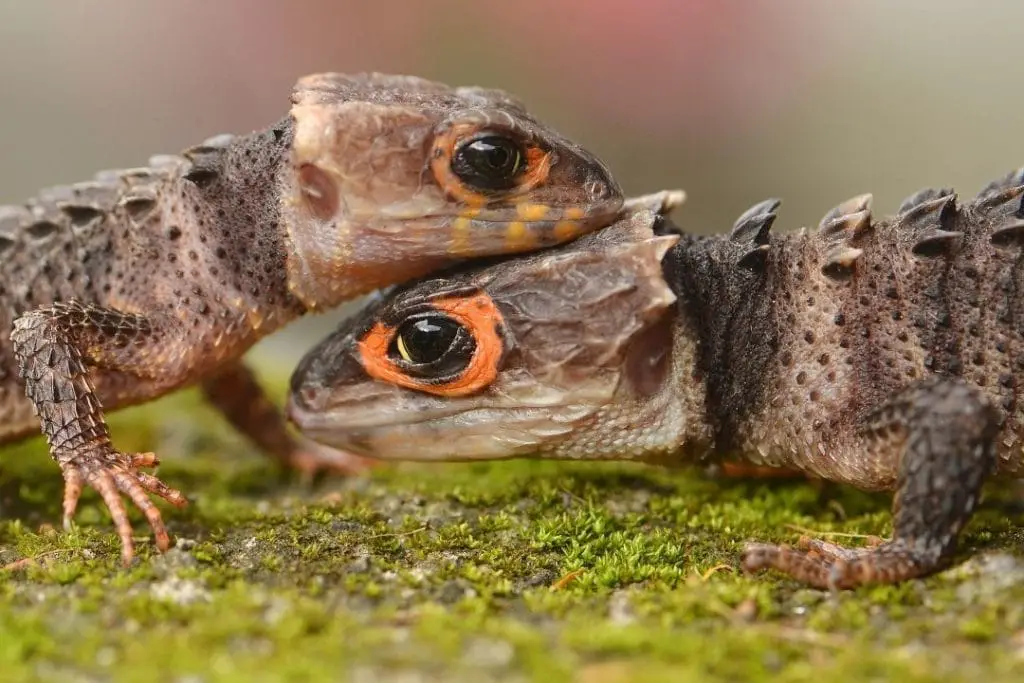
How to breed red-eyed crocodile skinks?
Red-eyed crocodile skinks will breed so long as they feel safe enough. If you house a pair, they will likely mate without extra effort.
You can increase the humidity and mist more frequently to simulate the rainy season from their native habitat. Females typically lay one egg at a time but will produce up to six eggs in a breeding season.
Female skinks do practice parental care, so you can honestly just let the female care for the eggs. She will be more defensive while caring for the eggs and may charge at you and vocalize if you check.
Provide extra moss and cork bark to help her create a safe nest. Females will also care for the hatchlings. Hatchlings will typically stick close to the mother and may be seen on her back.
You can remove eggs and hatch them on a moist hatching substrate and incubate them at 80 degrees. The mother does seem to be better at hatching.
She will typically lay another egg once the previous egg hatches.
Handling Red-eyed Crocodile Skinks
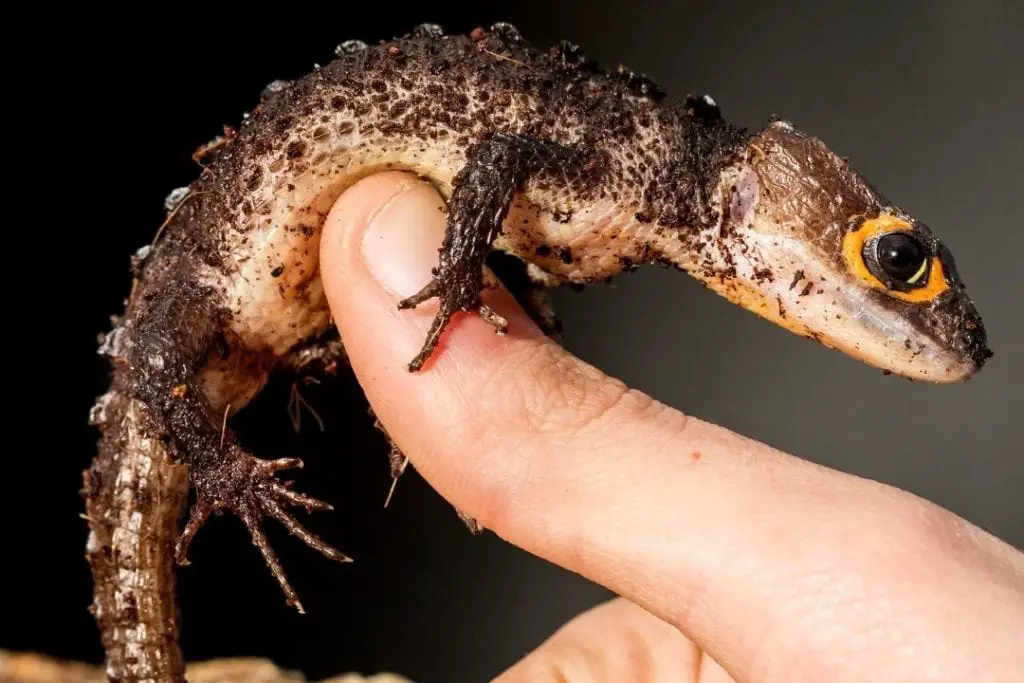
Wild-caught red-eyed crocodile skinks can be tamed, but it is difficult and may stress the animal to a fatal level.
Captive-bred skinks are a bit more relaxed, but they are typically a display animals. Your skink will be more willing to be handled if it has plenty of covers.
Generally, you can start using food to get your skink used to you.
A dish works well to make them less afraid of your hand, and you can then move on to tong feeding and then offering food from your hand after a few months.
When stressed, crocodile skinks often play dead; they will very rarely bite or show aggressive behavior.
They may step up onto your hand if you offer food, making them less afraid of your hand.
Positioning their enclosure closer to your eye level can also help the skinks feel more comfortable with you over time.
You shouldn’t expect to be able to handle them like a bearded dragon. They will likely only ever tolerate handling with the promise of a treat.
Frequently Asked Questions
This short section will cover some basic questions you may have about red-eyed crocodile skinks. If you don’t see your question answered here, feel free to ask in the comments below.
Red-Eyed Crocodile Skink Lifespan
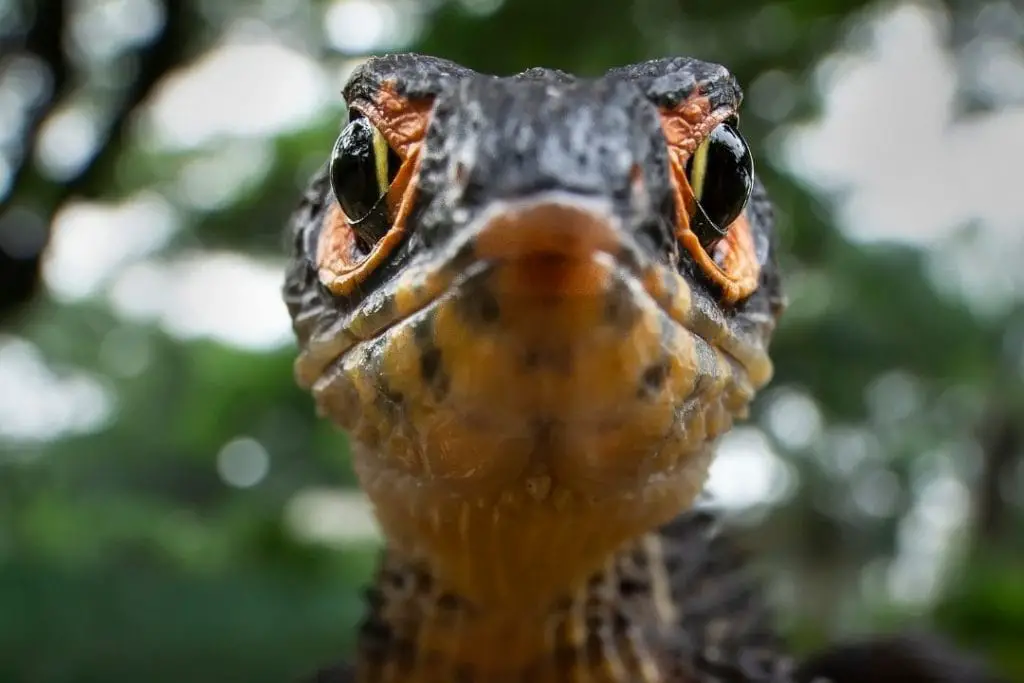
How long does a red-eyed crocodile skink live?
Red-eyed crocodile skinks can live up to 8-10 years. The exact age these animals can live isn’t quite established, but this is what is commonly reported in captivity.
Captive-bred animals that have been selected to be more tolerant of humans may live longer in the future.
They have only been in the reptile hobby for around 20 years, and the earliest husbandry guide for scientific institutions studying the species was published in the 90s.
Price
How much does a red-eyed crocodile skink cost?
Since the species is still rare, expect to pay a few hundred for an imported red eyed crocodile skink. Many animals go for around $200 and up.
Captive-bred animals are currently rare and will be more expensive since breeders mainly keep them to build up their breeding population.
Where Can I Buy a Red-Eyed Crocodile Skink?
There are a few websites that will sell the animals, but I highly recommend googling the company for honest reviews before buying an animal.
A few of the larger companies are known for shipping seriously ill animals. Morph Market can be a good source for finding the species, but you may only see a few animals at any time.
How Big Does a Red-Eyed Crocodile Skink Get?
Hatchlings are typically only a few inches long. An adult will be 6-8 inches and both sexes have a similar length. They will weigh around 62.7 grams for males and 49.3 grams for females.
Males have a broader head and have larger scales on the third and fourth toes of the back feet.
Are Red-Eyed Crocodile Skinks Good Pets?
Red eyed crocodile skinks can make great display pets if you can set up the enclosure enough to make them feel safe. They do not particularly like handling and may charge or squeak at you as a defensive behavior.
Crocodile skinks are not as popular in the pet trade as other skinks like the blue tongue skink or other lizards and geckos.
They make excellent display animals in a beautiful enclosure, thanks to their mini dinosaur look with dorsal scales and beautiful colors, but they are not the best species if you like to handle and interact with your lizards.
What is Their Natural Habitat?
The type location for the species is listed as a river in Papua New Guinea. Male and female skinks are also found in Indonesia. They prefer humid habitats with plenty of cover along rivers and streams.
Most pictures of wild animals show them close to the ground on forest debris and roots, near dense plants where they can burrow and hide from predators.
They also prefer staying near moist but not wet areas for incubating their eggs.
Are there other species of crocodile skinks?
While only the red eye crocodile skink (Tribolonotus gracilis) is commonly found in the pet trade, there are ten known species of crocodile skinks:
| Common name | Scientific name | Distribution |
|---|---|---|
| Zweifel’s helmet skink, New Britain spiny skink | Tribolonotus annectens | New Britain |
| Blanchard’s helmet skink | Tribolonotus blanchardi | Bougainville and the Solomon Islands |
| Admiralty spiny skink, Brongersma’s helmet skink | Tribolonotus brongersmai | Admiralty Islands |
| Tribolonotus choiseulensis | Solomon Islands | |
| red-eyed crocodile skink, red-eyed bush crocodile skink | Tribolonotus gracilis | New Guinea |
| white-eyed crocodile skink | Tribolonotus novaeguineae | Irian Jaya and Papua New Guinea |
| Tribolonotus parkeri | Buka Island | |
| giant spiny skink, Poncelet’s helmet skink | Tribolonotus ponceleti | Solomon Islands |
| western crocodile skink, false Poncelet’s helmet skink | Tribolonotus pseudoponceleti | Bougainville and Buka |
| Schmidt’s helmet skink, Schmidt’s crocodile skink | Tribolonotus schmidti | Guadalcanal in the Solomon Islands |
Sources
- Vocalization of the crocodile skink, Tribolonotus gracilis (De Rooy, 1909), and evidence of parental care
- A Case of Mortality Caused by Aeromonas hydrophilain Wild-Caught Red-Eyed Crocodile Skinks (Tribolonotus gracilis)
- Baines, F. M., Chattell, J., Dale, J., Garrick, D., Gill, I., Goetz, M., Skelton, T., & Swatman, M. (2016). How much UVB does my reptile need? The UV-Tool, a guide to the selection of UV lighting for reptiles and amphibians in captivity. Journal of Zoo and Aquarium Research, 1, 56. https://doi.org/10.19227/jzar.v4i1.150
- Crepuscular Species. (n.d.). Arcadia Reptile. Retrieved January 10, 2022, from https://www.arcadiareptile.com/lighting/crepuscular-species/
- Hartdegen, R. W., Russell, M. J., & Young, B. (2001). VOCALIZATION OF THE CROCODILE SKINK, TRIBOLONOTUS GRACILIS (DE ROOY, 1909), AND EVIDENCE OF PARENTAL CARE. Contemporary Herpetology, 1–6. https://doi.org/10.17161/ch.vi1.11956
- Red eyed Crocodile Skink Care. (n.d.). CHICAGO EXOTICS ANIMAL HOSPITAL. Retrieved January 17, 2022, from http://www.exoticpetvet.com/red-eyed-crocodile-skink-care.html
- Tribolonotus gracilis. (n.d.). The Reptile Database. Retrieved January 17, 2022, from https://reptile-database.reptarium.cz/species?genus=Tribolonotus&species=gracilis
- Wheeler, W. (2017, November 3). Red-Eyed Crocodile Skink Care And Information. Reptiles Magazine. https://www.reptilesmagazine.com/red-eyed-crocodile-skink-care-and-information/
Conclusion
We hope this has taught you more about how to care for red-eyed crocodile skinks.
These dark brown mini crocodiles with their small keeled scales, red orange scales and a bright reddish-orange semicircle on their eye are amazing to look at.
They are not an easy species to keep for a beginner since they are so sensitive and need special care to be able to handle them enough for essential care.
If you have any questions or comments, please leave them below.
